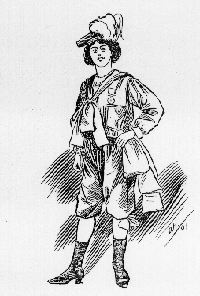The Ballooning Spencers and Smiths
by Nick Peacey
Three graves in St Pancras & Islington Cemetery hold the remains of families who provided entertainment – and much else – to Victorian and Edwardian London.
The monument to George Cuvier Spencer is near the entrance. Cuvie, as he was known, was one of a celebrated ballooning family, but he made his living in a more earthbound business – manufacturing gymnastic equipment and blinds.
His firm supplied gymnastic equipment to the Titanic, but its greatest coup was the introduction of the velocipede from France in 1868. Charles Dickens bought one and, at £10 a time, the machines flowed out the shop in Goswell Road as fast as they were made.
Cuvie was famous for physical fitness. A 1909 profile in the Muswell Hill Record read, 'even today [he was then 77] his muscles are as taut and tough as those of a champion athlete. Thus it is that he is known to all his friends and acquaintances as "The Boy".'
'The Boy' died in 1916. He outlived many of the succeeding generation of the Spencer family, including one of the most famous of them all – his nephew Percival Spencer, who was buried in the Islington part of the cemetery, beneath a fine stone air balloon.
Percy ran C. G. Spencer & Sons – the most famous balloon manufacturers and pilots in Britain. They made balloons for fêtes and for military and advertising purposes; they conducted parachute jumps and ran juvenile balloon races; and Percy went on many ascents with scientists, and experimented with aerial photography.
In 1902 a serious challenge to the Spencers' supremacy came from France. Santos Dumont, the son of a Brazilian coffee millionaire, was building navigable air balloons in Paris. They were getting better all the time. It was rumoured that he parked his balloon outside his flat. No one in Britain had a balloon you could steer, but Spencer's decided to have a go.
The third set of distinguished residents of the cemetery now comes into the story.
Spencer's employed a team of aeronauts for engagements up and down the country. The men were usually pilots and parachutists; the women were parachutists. One couple, Alfred and Ellen Smith, were known professionally as 'Captain' Smith and 'Countess S'. Their grave is familiar to visitors to the St Pancras part of the cemetery – it has a representation of a parachutist who is often assumed to be 'Harry Gardner, the famous Lyceum clown', commemorated on the headstone. In fact the Smith's were the parachutists; Ellen's maiden name was almost certainly Gardner, so Harry was probably her brother.

| 
| |
| "Captain" Smith | "Countess S" | |
The Smiths' relationship with the Spencers (or most of them) came to an unfortunate end in October 1903. The Spencer navigable balloon, advertising Mellins Baby Food, made well-publicized flights across London, but it was not a huge success. Its steering was not very effective, and it could not circumnavigate St Paul's Cathedral as had been planned.
Mellins refused to pay the full advertising fee for the advertising space; Spencer's sued them for £500.
Alfred Smith testified that he and a ground crew had towed the balloon around the polo ground at Crystal Palace to give the impression that it was navigable. Spencer's were not awarded their £500, but the jury ruled they should keep the £1,000 Mellins had already paid.
After that, the Smiths were out of a job. In 1903 there was only one other place they could go: to Auguste Gaudron's firm, based at Alexandra Palace.
Gaudron was a Frenchman who came to Spencer's as an apprentice, married the boss's daughter, and founded a rival firm with yet another Spencer brother, Harry. 'Countess S' seems to have given up parachuting by then, but 'Captain' Smith worked for Gaudron for several years. It has been suggested that he met with a serious parachute accident which finished his career; all we know for sure is that he died in 1914 and his Countess much later, in 1936.
Percy Spencer and Auguste Gaudron died in the same year, 1913. And, of course, when Gaudron was buried in Highgate Cemetery his tomb was topped by a stone balloon every bit as magnificent as that of Percy Spencer in Islington.